7
Broader Impact of AMO Science
Atomic, molecular, and optical (AMO) science advances have had enormous influence on numerous scientific disciplines and technology development, including astronomy, astrophysics, cosmology, particle physics, condensed-matter physics, life sciences, and engineering, with strong impact to present-day industry. Often times, new research concepts and development in AMO can have surprising applications in other fields of physical sciences. At the same time, the desire for developing better tools to pursue a particular research direction can stimulate new ideas in AMO. Two recent Nobel Prizes have been awarded for AMO-driven advances that have transformed biological sciences: super-resolution fluorescence microscopy (2014, Chemistry) and optical tweezers (2018, Physics). As noted previously, the 2017 Nobel Prize in Physics for the detection of gravitational waves with the Laser Interferometer Gravitational-Wave Observatory (LIGO) is a particularly remarkable example of the intersection of AMO physics with other disciplines. In this chapter, the committee discusses a range of topics outside AMO, or right at the boundaries of AMO and other scientific disciplines, listing a number of active examples where AMO physics is having strong impact. These two-way connections make AMO one of the most central and most vibrant areas in science today.
THE LIFE SCIENCES AND AMO
Life is organized on multiple scales, from atoms assembled into molecules such as proteins and DNA, to molecules organized into cellular substructures like organelles, to the “society” of organelles and molecules comprising a cell, to the
hundreds of billions of cells making up organs and the human body as a whole. Proteins are often called nanomachines because they are nanometers in size and do critical machine-like jobs in the body, but they do so with a precision and efficiency still unmatched by human-made machines. AMO sciences have helped deepen our understanding of their function in our bodies, in normal as well as in diseased states, through advances in light sources and imaging/spectroscopy technologies, and through new ways to manipulate these components, such as with the optical tweezers mentioned at the beginning of this chapter. These newfound abilities have enabled investigation at ever higher resolution, and in situations/environments closer to native conditions.
Protein Structure Determination Using X-ray Free-Electron Lasers
X-ray crystallography can be used to obtain atomic resolution structures of proteins, but until recently has required a high-quality crystal of the material to be examined. Crystallizing a significant amount of a material is often forbiddingly difficult. This is especially true for membrane proteins, which are important therapeutic targets. Since the early days of planning for an X-ray free-electron laser (XFEL), scientists have dreamed of the possibility of making structure determinations without having to crystalize molecules, perhaps obtaining structure from even single molecules. A major step in that direction was made in 2011. Serial femtosecond crystallography, with its intense femtosecond X rays, generated diffraction signals before radiation damage could occur, using nanocrystals that are too tiny for conventional crystallography (see Figure 7.1). Combining many such diffraction patterns obtained serially gave high-resolution structural information. By precise timing of X-ray pulses relative to a laser pulse used to trigger a photochemical reaction in a light-sensitive membrane protein, we can now record movies of their structural changes on femtosecond time scales and at atomic resolution, as they perform their function in, for example, photosynthesis and vision. In the future, serial femtosecond crystallography may be extended to the single-molecule level, altogether bypassing the need for crystallization. In addition, exciting developments may emerge when X-ray measurements that are element specific are combined with other spectroscopies such as Raman.
Single-Molecule Measurement Technologies
X-ray crystallography typically provides only a static snapshot of many possible structures of a biological molecule. Ideally, one would like to measure structural changes in real time during the functioning of a single molecule in its native environment—that is, free in solution or inside a living cell. To relate structural changes to function, powerful single-molecule measurement technologies have
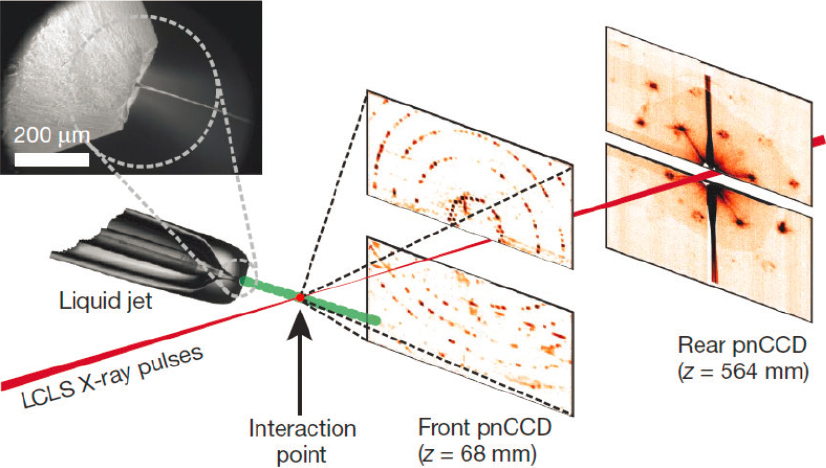
been developed. For example, one can do this combining single fluorophore detection and optical tweezers (which, as mentioned earlier were respectively the subjects of the 2014 and 2018 Nobel Prizes). Optical tweezers apply pico-Newton scale forces, and detect a molecule’s ~0.1 nm scale response through end-to-end distance measurements, but are blind to the intramolecular structural changes. By combining ultrahigh-resolution optical tweezer studies with single-molecule fluorescence spectroscopy, researchers are able to measure the action of a motor protein on DNA at single base pair resolution, and correlate it directly with the associated structural changes (see Figure 7.2). This hybrid single-molecule approach is just one example of maximizing the information content through simultaneous measurements of multiple observables, greatly aiding our investigation of complex biomolecular assemblages of many components.
Super-Resolution Imaging
Super-resolution techniques have provided a new glimpse into subcellular structures, at a resolution down to 20-30 nm. This goes an order of magnitude beyond the resolution limit imposed by light diffraction, and increasingly takes us into the realm of the function of living cells. This already has had broad-based
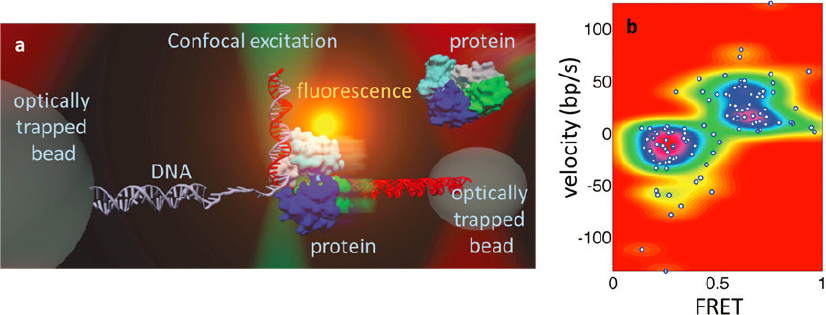
impact not only on fundamental understanding of biological processes but also on the dysfunction that leads to disease. These advances, including stimulated emission depletion (STED) microscopy and single-molecule localization microscopy (also known through acronyms such as PALM and STORM), were recognized by the 2014 Nobel Prize in Chemistry. A striking example of biological findings uniquely enabled by super-resolution imaging is the discovery of periodic actin ring structures in neurons. (See Box 7.1, which also illustrates the concept of STORM.) In the future, super-resolution techniques will provide key insights into disease mechanisms, and we will fully visualize and characterize the “inner life of a cell” through three-dimensional (3D) imaging with true molecular resolution. All that is needed is another factor of 10 jump in spatial resolution, to about 2-3 nm. Technologies that require many fewer photons for high-resolution imaging—for example, the recently demonstrated nanometer resolution achieved with minimal photon fluxes—are promising avenues to pursue. Breakthroughs in super-resolution imaging technologies have also inspired other advances in probe development, sample preparation, and image analysis algorithms.
Live Imaging of Native Cells and Tissues
In order to observe molecular movements and activities in their native environment, we need to be able to label individual molecules, and image them in live cells and tissues with minimal perturbation. A challenge lies in photo-toxicity. Laser excitation

of fluorescent probe molecules generates reactive oxygen species and free radicals that greatly perturb the biological processes under study, if not outright killing the cell. Light-sheet microscopy was developed to reduce phototoxicity during the imaging of large 3D samples such as tissues and whole animals. A sheet of light just 400 nm in thickness can be prepared through a special optical technique known as Bessel beam engineering, making sure that no probe is excited unless the signal is being collected from that probe. In addition to nearly eliminating phototoxicity, light-sheet microscopy greatly reduces photo-bleaching and off-focus background noise (see Figure 7.3).
It is now possible to image, at subwavelength resolution, immune cells crawling inside blood vessels in search of pathogens and tumors—even in a living animal—over hours-long time scales. Another advance is the use of adaptive optics, originally developed for astronomy, to compensate for optical aberrations that occur when light propagates through deep tissues with inhomogeneous optical properties. In addition, optogenetics has enabled newfound control over not only cellular processes (primarily neurons at this point) but also circuit-level functioning in more complex neural systems, including the brain. In the future, optogenetics will extend beyond neurons into nonexcitable cells; it will become possible to optically control the function of many different cell types, for example metabolic processes in yeast as recently demonstrated. Live cell imaging can also be performed with vibrational energy contrast, for example using stimulated Raman scattering microscopy, to probe cellular- and tissue-level dynamics with chemical specificity without the need to label the sample fluorescently. The committee expects that it may become possible to exploit quantum control effects through coherent control of light-responsive proteins to drive cell metabolism, behavior, function, and interactions.
Medical Imaging
The way we currently examine tissues from the body under a microscope for signs of disease, known as histopathology, is archaic. Standard histopathology is moreover time and labor intensive, and in need of technological advances that will
enable point-of-procedure visualization of molecular-, cellular-, and tissue-level changes. Advances in low spatial coherence light sources and speckle reduction methods (see Box 7.2), and label-free optical imaging, are bringing us closer to replacing these decades-old practices in hospitals. Challenges of multiple light scattering in deep tissue imaging may be overcome through coherent control of the light wave front. In the future, slide-free and stain-free optical imaging will first augment but then potentially replace histopathology for more point-of-care and point-of procedure medical decision making.
Impact of Nontraditional Research Entities on AMO in Life Sciences
Instead of providing research grants, philanthropic organizations have built their own research entities. Examples are the Janelia Research Campus (JRC) by the Howard Hughes Medical Institute, the Allen Institute, and the Chan-Zuckerberg Initiative. All three have strong emphasis on developing imaging technologies. Their successes—for example, super-resolution fluorescence imaging and lattice light-sheet microscopy highlighted above and pioneered at JRC—showed that nontraditional research entities outside universities and national laboratories can nevertheless become hotbeds of innovation and discoveries. Stable institutional support for technical staff, freedom from administration and grant writing for the group leaders, and small group size may have contributed to their success. In addition, non-AMO advances—for example, the development of fluorescent probes and reporters—are motivated by advances in AMO technologies and vice versa, and such virtuous cycles can be repeated by co-localization of scientists and engineers of different breeds. More rapid adoption of the latest AMO technologies into life sciences will also become possible by raising the awareness and availability of these technologies through such co-localization.
ASTRONOMY, ASTROPHYSICS, GRAVITATION, COSMOLOGY, AND AMO
Humanity’s hunger for understanding the unknown has stimulated exciting improvements in telescopic capabilities, such as photon collection area, spatial resolution, and spectral sensitivity. AMO physics has been crucial in extracting much of what we have learned from such observations of cosmic phenomena. But while tremendous advances have resulted from these billion-dollar investments and the resulting observations, opportunities exist to learn far more by advancing our understanding of the basic underlying theory. This includes continuing to develop understanding of collisions, reactivity, and spectroscopy involving key species—for example, from applying existing methods to more astrophysically relevant molecules, to aid the simple but critical task of identifying the species being observed astronomically. Other information can be gleaned only through
advances in fundamental theoretical understanding, computational capability, and associated advances in AMO experiments needed to describe correlated behaviors ranging from complex reactive processes, to entanglement, to AdS/CFT duality.
Exoplanets
More than 4,000 exoplanets have been discovered to date. Observational constraints have limited these primarily to planets more massive than Earth, or with smaller separations from their host stars. Targeted searches now beginning for Earth-like planets, with masses and orbits similar to Earth’s, require visible and infrared spectrometers calibrated to an accuracy of a few parts in 109 or better, and with stability maintained for periods of time on the order of decades. Clues to the habitability of exoplanets are provided by their atmospheres. However, our ability to interpret exoplanetary atmospheres is limited by shortcomings in our understanding of the underlying molecular physics that generates the observed spectra.
Exoplanets circling distant stars can be discovered and their characteristics measured by two distinct methods, both involving important technologies from AMO. Direct observation of light reflected from the planet is difficult because light from the star can be of order 1 billion times more intense than the reflected planetary light. To get around this, the so-called transit method works well for the small fraction of planets (<0.5 percent for Earth-like) that happen to be perfectly aligned so that they pass in front of the star. This passage causes a partial eclipse that very slightly reduces the intensity of light from the star (by roughly 1 part in 10,000 for an Earth-like planet, leading to risks of false positives). The magnitude of the reduction can be used to measure the planet’s diameter, and in the future it may ultimately be possible to detect spectral signatures of biomolecules using the stellar light that passes through the atmosphere of the planet.
The Doppler method is a complementary technique that relies on the small changes in the velocity of the star relative to Earth induced by the gravitational tug of the orbiting planet on the star. The small change in the radial velocity (RV) of the star in turn induces a very small Doppler shift in the apparent frequency of atomic spectral lines in the light emitted by the star. The RV method thus obtains the mass of the planet, and when combined with the transit method determination of the radius, one obtains the density. This is essential for determining whether the planet is rocky or gaseous. Jupiter-like giant planets can produce stellar RV oscillations of 50 m/s (see data for 51 Pegasi b;1 and see Figure 7.4a,b), but the Sun moves only 9 cm/s due to the motion of Earth. At this low velocity, the Doppler shift of the light frequency is only 3 parts in 10 billion.
___________________
1 Mayor and Queloz, 1995.
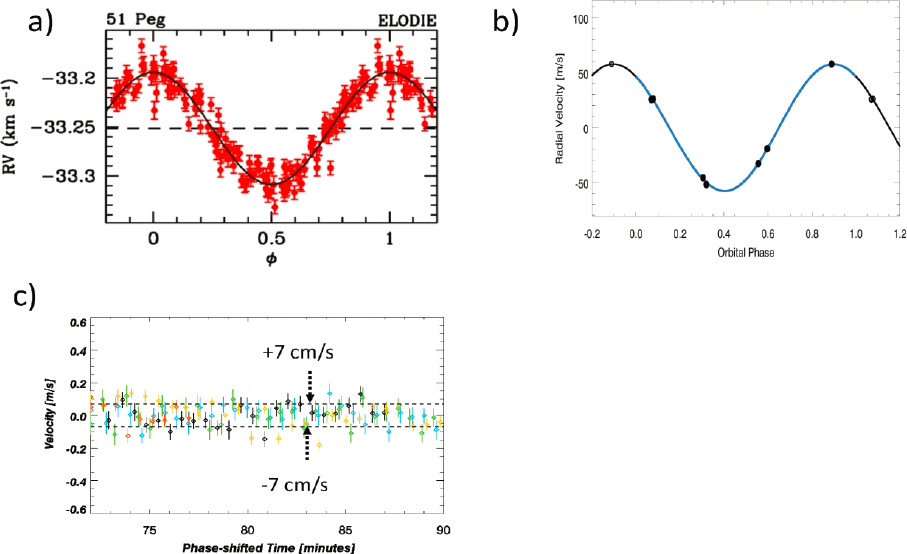
To get a sense of just how small this Doppler shift is, the image transmitted by the spectrograph to its silicon chip CCD camera is shifted only the diameter of ~10 silicon atoms! Technological advances over the past 20 years have increased the precision of RV measurements to 7 cm/s (shown in Figure 7.4c). This remarkable feat was enabled by the AMO community’s invention of optical frequency combs (astro-combs) that can lay down an array of spectral lines with fixed and stable frequency to continuously calibrate the spectrograph and remove long-term drifts due to numerous systematic errors. This is critically important because the small RV oscillations caused by Earth-like planets have to be followed for several orbital periods (i.e., several years to a decade) in order to confirm the existence of the exoplanet, and to accurately determine its orbital parameters. It has until now been essentially impossible to maintain the required level of mechanical and optical stability over multiyear periods, so the continuous absolute frequency calibration by optical frequency combs will be revolutionary for exoplanet astronomy.
AMO techniques for precision timekeeping and GPS positioning are also essential for determining the ephemeris of the telescope—the exact position and velocity changes of the telescope as Earth rotates around its axis and orbits the Sun. These effects produce huge RV changes of order 30 km/s; but through modern precision measurements these can be determined and removed from the signal with an accuracy better than 1 mm/s!
In the future, precision RV measurements of the type used to detect exoplanets will also be able to determine the accelerations of individual stars in our galactic neighborhood due to the presence of the other stars and the dark matter (DM) within our galaxy. These measurements can be used to directly probe the local gravitational potential and measure the local DM density, potentially allowing us to map out the gravitational potential of the galaxy. Knowledge of the Milky Way DM density is crucial to direct and indirect searches for the as-yet undiscovered particles comprising DM, as well as for our understanding of the standard cosmological model. Next-generation large telescopes, combined with the exquisite RV precision and stability achievable with astro-comb wavelength calibrators and exoplanet spectrographs, may make it feasible to measure stellar accelerations directly at the necessary level of 10−8 cm/s2.
The Molecular Universe
Clues to the habitability of an exoplanet can be gleaned from spectroscopic observations of the chemical composition of its atmosphere. As a planet passes before its host star, the star light is filtered by the planet’s atmosphere, yielding spectroscopic data. The planned 2021 launch of the James Webb Space Telescope (JWST) will open the near- and mid-infrared (IR) range to spectroscopy of planetary atmospheres. But our ability to interpret exoplanetary atmospheres is limited by shortcomings in our understanding of the underlying molecular physics that generates the observed spectra. The spectra of many molecules are incomplete, incorrect, or completely unknown. Some of the important molecules include H2O, CO2, CH4, O3, CO, NH3, TiO, VO, HCN, C2S2, H2S, PH3, SO2, HCl, HF, OH, SiO, KOH, and KCl. Data are needed for pressure-induced line broadening parameters, continuum opacity due to collision-induced absorption, molecular opacities at high spectral resolution, photoabsorption cross-sections for molecules at high temperatures, and expanded databases for atmospherically relevant chemical reactions.
With the construction of impressive facilities such as the Atacama Large Millimeter/submillimeter Array (ALMA), the Stratospheric Observatory for Infrared Astronomy (SOFIA), and the upcoming JWST mentioned above, a flood of spectral data on complex molecular features is eagerly anticipated. However, a longstanding difficulty is the fact that the species responsible for the vast majority of the astronomically observed molecular spectral features remain unidentified. Many of
these are thought to be due to complex molecules with both known and unknown spectra, such as polyaromatic hydrocarbons (PAHs), which are abundant in space. Theoretical methods are still not sufficiently accurate to predict molecular spectra reliably. Laboratory spectra are the only reliable way at present to identify molecules in space, but experimental efforts can be time consuming, and at the current rate of progress, only a few new molecules are being identified per year. The bottom line is that new AMO theoretical advances and experiments in molecular spectroscopy are needed in order to unlock the full mystery of the molecular universe. Moreover, advances in reactive scattering techniques are needed so that we can reliably model and interpret the molecular properties of the cosmos.
In some cases, application of current methods can suffice, while in many cases there are opportunities for truly creative efforts that are needed to overcome current limitations in our intellectual ability to identify even the qualitative nature of complex reaction mechanisms. One promising experimental advance is a facility that has just become operational, the ion Cryogenic Storage Ring (CSR) at the Max Planck Institute for Nuclear Physics in Heidelberg, Germany, which can measure inelastic collision rates and molecular destruction rates by electron collisions with molecular cations at the low temperatures (10-100 K) that are relevant to interstellar clouds. The Desiree Ring in Stockholm is focused on ion collisions. AMO groups in the United States also are preparing experiments to study collisions and reactions of trapped and cooled molecular ions with cold and slow beams of free radicals. At present, however, very few AMO theorists are supported in the United States to develop a theoretical interpretation of the experimental results that these facilities are beginning to produce.
Gravity and Cosmology
As already discussed in Chapter 6, gravitational waves are opening up a new frontier in astrophysics and cosmology. Squeezed light methods, combined with enhanced power in the laser interferometer detectors, are predicted to enhance gravitational wave detection at high frequencies (50-5,000 Hz). These advances will double the spatial detection volume, provide better sky localization (source direction determination), enable better estimates for the tidal deformability parameters of the merging compact objects, open up the ability to study the post-merger phase, and constrain the neutron star equation of state. Alternative AMO ideas, such as large-scale atom-interferometric gravitational wave detectors, have the potential to open up lower frequency regimes. Continued advances in AMO techniques hold the promise of expanding our ability to use gravitational waves to help unravel the mystery of the cosmos.
In 2019, radio astronomers in the Event Horizon Telescope collaboration successfully completed a monumental 14-year quest to produce the first-ever image of
a black hole 55 million light years from Earth. Resolving such a small object at such a great distance required the use of a “virtual” radio telescope effectively the size of the entire Earth—created by combining signals from many different telescopes from around the world. In order to be able to digitally combine these disparate radio signals, days and weeks after they were recorded, each one had to be “time stamped” with its exact arrival time, with exquisite resolution. This in turn required high-precision atomic clocks (commercial hydrogen masers with frequency stability of 2 parts in 1014 over 10 seconds), synchronized and given long-term stability via the GPS satellite time system, which in turn is based on rubidium atomic clocks. Without these products of AMO science, the spectacular image shown in Figure 7.5 would not have been possible.
A more foundational impact of AMO on gravitational physics (and cosmology) comes through the string-theoretic AdS/CFT duality. This is a now decades-old
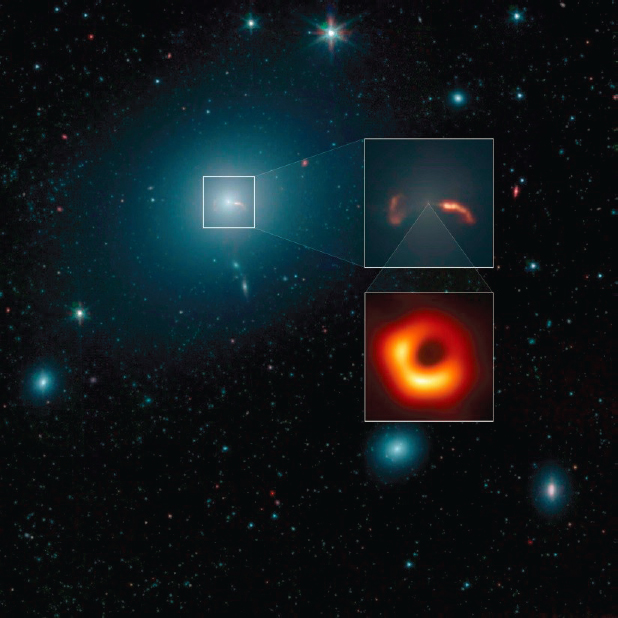
relationship between gravitation in a particular geometric background (AdS space) and quantum theory (specifically, conformal field theory [CFT]). It has recently become clear that this AdS/CFT duality means that space-time geometry and quantum entanglement are closely related. In particular, the former could be an emergent property of the latter! In this picture, entanglement in the quantum theory is responsible for the emergence of geometry on the gravitational side of the duality. However, entanglement is also responsible for thermalization in the quantum system (see more about this in the following section). With large-scale entanglement responsible for the geometry leading to black hole formation on one side of the duality, and the process behind equilibration and thermalization (by hiding information in the inaccessible global correlations that are due to entanglement) on the other side of the duality, the “loss” of information in thermalization appears to be dual to the “black hole information paradox” of cosmology. In neither case is information really lost—it is just impossibly hard to recover.
STATISTICAL PHYSICS, QUANTUM THERMALIZATION, EMERGENCE OF THE CLASSICAL WORLD, AND AMO
As the section title implies, AMO provides a good platform to explore how macroscopic systems are able to come to equilibrium and the emergence of the classical world from the quantum. These are possibly among the most fundamental questions in all of physics. Emergence of complexity from few-body physics is discussed in Chapter 3, along with the topic of thermalization, which has always had a bit of paradox associated with it. How can a system seemingly always move toward equilibrium when in fact the underlying dynamics is reversible due to time-reversal invariance? Chaos seemed to come to the rescue, as small perturbations could prevent the dynamics from exactly following the reverse path. But quantum mechanics throws a wrench in this picture, as there is still reversibility because of unitary evolution of the wave function. This means among other things that the entropy of the system cannot be increasing, as would be expected as one moves toward equilibrium. What then is the answer to thermalization?
Entanglement appears to be intimately connected to the answer to this and to the emergence of equilibrium, as well as of classicality. Theoretical work from the past decade or more sheds light on this by means of the eigenstate thermalization hypothesis (ETH). It is a picture that shows us how quantum systems might nevertheless thermalize. The framework in ETH that connects microscopic models and macroscopic phenomena is based on having highly entangled quantum states. As AMO provides the means to generate entangled states, it is the right field in which this hypothesis can be tested. Specifically, systems can be realized and exquisitely controlled in AMO experiments, and in quantum gas microscopes in particular. Very recent experiments employing such a quantum gas microscope studied strings
of rubidium atoms confined in the wells of an optical lattice. Initially, the wells contain atoms that are isolated and noninteracting. When tunneling interactions are enabled, the system as a whole remains in a pure state, but smaller subsets of atoms start to follow a thermal distribution. This experimentally allowed the observation of the emergence of statistical mechanics in a quantum system. The fundamental role of quantum entanglement in facilitating this emergence was observed. The measurement of parts of an entangled state creates a local entropy. The subsystem is no longer a pure state, but rather in a statistically mixed state. This occurs even in as simple a system as a Bell pair of states, but occurs to a much higher degree in a strongly entangled macroscopic system.
AMO measurements in a quantum gas microscope enable such measurements, and have in fact shown that the approach to equilibrium is consistent with the ETH. A globally pure quantum state is acting at a local level like a classical system evolving under the laws of statistical mechanics.
In this understanding, thermalization in a quantum system happens despite unitarity: information is not lost but inexorably hidden in the growingly inaccessible complex global correlations resulting from entanglement, which are inaccessible to local measurements.
It is more speculative, but it appears that the entanglement entropy, the source of thermalization, might also be responsible for the emergence of the observed classicality of our experienced world. This local classicality then allows for dynamics that is (also locally) classically chaotic, taking us full circle back to how chaos indeed does help to explain thermalization after all.
In conclusion, AMO-based ideas and approaches, in particular revolving around creation and manipulation of entanglement, could be central to answering questions as significant as the emergence of the second law of thermodynamics, the emergence of gravitation, and the very emergence of the classical world. AMO science can continue to contribute to these foundational questions through studies of large-scale entanglement.
CONDENSED MATTER AND AMO
It was not all that long ago since Art Schawlow said, jokingly, of AMO physics that “a diatomic molecule has one atom too many.” Nevertheless, for two decades now atomic physics has ventured well beyond two atoms, and well beyond even molecular physics.
The impact of AMO physics on statistical mechanics and condensed-matter physics (CMP) came through the creation first of Bose-Einstein condensates (BECs), and then quantum degenerate Fermi gases, exploring their crossover, exotic pairing mechanisms, and other questions clearly in the realm of statistical mechanics. This trend is picking up speed in areas such as the creation and study
of novel phases of matter (including dynamically induced phases). Unlike in CMP, the interactions in AMO physics are readily tunable, and the systems are “clean” (e.g., largely without defects or disorder unless one wishes to explicitly study those effects, and if desired, limited to only those terms considered to embody the key physics).
Over the past decade, AMO-based quantum simulation, particularly of CMP phenomena, has become ever more widespread in use and application. At the same time, techniques have been continually refined, becoming ever more controlled, having moved from simple optical lattices to quantum gas microscopes to the current degree of sublime control seen in optical tweezer arrays (highlighted in Chapters 3 and 4). In the simulated systems, one can go beyond studying novel phases of matter and phase transitions—for example, by investigation of otherwise inaccessible quantum phase transitions (occurring at zero absolute temperature). One can also study CMP model Hamiltonians that underlie a variety of phenomena including magnetism and novel superconductivity. Furthermore, AMO techniques permit direct access to the full wave function of the model system through measurement techniques not generally available in CMP.
A specific question under study this past decade, but still to be resolved, is the nature of high-temperature superconductivity. Does the Fermi-Hubbard model (an extremely elegant but highly simplified model) contain the necessary physics? And if not, what minimal additional terms might be required? Computer simulations of even this simple model are intractable because of the exponential scaling of the dimensionality of the Hilbert space with the number of quantum particles. AMO-based quantum simulation has been demonstrated on systems far larger than anything tractable on a classical computer—for example, the antiferromagnetic Néel state has been observed. However, the high-temperature superconducting phase remains elusive. Is this phase to be found in this simple model? Holding AMO-based studies back at the moment is the necessity of reaching yet colder temperatures, and more fundamentally, understanding how and under what circumstances closed quantum systems reach equilibrium (discussed in the previous section). These obstacles are themselves important and unsolved problems traditionally considered outside the realm of AMO physics—but now very much a part of it.
Additionally, AMO physics has become the realm in which to observe many CMP phenomena clearly and cleanly, such as the Mott insulator transition, Bloch oscillations (due to the presence of “tilted” periodic potentials), and perhaps soon, quantum spin liquids. The connection between CMP and AMO has been growing since the realization of BECs, with the area of quantum simulations of CMP systems as described above being a big one in recent years. A few specific examples of this growing crossover between these fields that has taken place during this past decade can be seen in the two highlights described below.
Polariton Bose-Einstein Condensates
Excitons are an analogue for CMP of what the hydrogen atom is for atomic physics. They are hydrogen-like bound states of a negatively charged electron in the conduction band and a positively charged hole (missing electron) in the valence band of a semiconductor. When a photon travels through a solid, it can be absorbed to create an exciton. Conversely, the exciton can disappear by annihilating the electron with its antiparticle (the hole) and creating a photon. Remarkably, when these two processes are quantum coherent, the true excitation in the solid is neither photon nor exciton but a coherent superposition of both at the same time. Such coherent light-matter excitations are known as polaritons.
In the past decade, there has been exciting experimental progress in engineering the properties of excitons in artificially structured semiconductors. As shown in Figure 7.6, the excitons can be confined to a thin, two-dimensional (2D) sheet by means of a quantum well, and the photons can be confined to the same region by a pair of surrounding mirrors that are highly reflecting. This results in the formation of highly coherent polaritons with lifetimes that are greatly enhanced by the confinement.
In addition, the confinement gives the polaritons an effective mass that is three orders of magnitude smaller than the electron mass. The low mass in turn means that the particles can form a Bose-Einstein condensate, not at the 100 nano-Kelvin scale seen for cold atomic gases, but rather at temperatures of tens of Kelvins, as shown in Figure 7.7. Furthermore, unlike ordinary photons, polaritons can collide and scatter from each other due to their repulsive interactions. This means that on top of forming a BEC, they also form a superfluid that can flow past obstacles
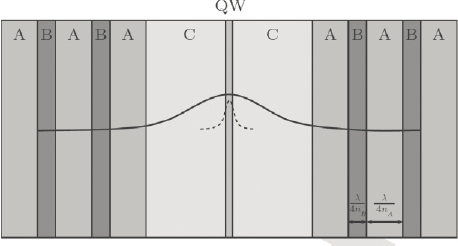
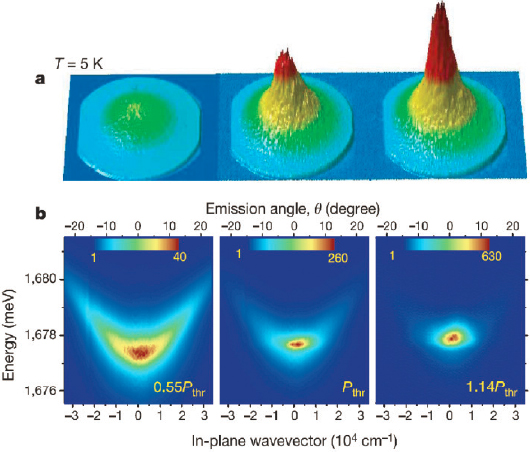
without any resistance. This can be directly observed experimentally by using a tilted laser beam to form the polariton condensate with nonzero momentum that allows the experimenter for the first time to directly image the quantum wave function associated with superfluid flow around obstacles. The repulsive interactions bring in other related phenomena including collective density waves that travel through the polaritons “fluid” at what can be called the “speed of sound of light.” This is one example of an exciting new subfield that is opening up in which photons and polaritons are the elementary quanta of correlated and interacting quantum systems.
Light-Induced Phases of Matter
When an intense laser pulse is incident on a material, light is typically absorbed by the electrons, resulting in an electronic excited state. However, if the energy of
the light is tuned to a frequency below the absorption threshold, novel quantum effects can come into play. In this regime, light can coherently hybridize with electrons inside the solid, generating quantum superpositions of photon-electron states named Floquet-Bloch (FB) states. Experimental observation of these states was recently achieved by making a “movie” of the electronic energy levels while the material was illuminated with low-frequency light. This discovery paves the way for optical manipulation of quantum states of matter. It could enable changing the phase of a material with light, such as switching it from being conducting to insulating, or transparent to opaque, simply by changing the properties of the light such as polarization, intensity, or frequency. For example, the symmetry that makes the energy of two different electronic states (“valleys”) equal in certain semiconductors can be broken using circularly polarized light, lifting the energy degeneracy as if a huge magnetic field had been applied. In other materials, the application of light seems to enhance the appearance of superconductivity. The field of light-controlled solid matter is still in its infancy, but from these examples it seems to hold promise for the manipulation of matter, both in furthering science and for future applications.
ADVANCED ACCELERATOR CONCEPTS
Another connection of AMO physics, this time to the high-energy frontier, is through accelerator physics. Although not a new idea, over the past decade breakthroughs in AMO science have led to laser technologies that will enable so-called wake-field accelerators that would be far more compact (and economical) than conventional large-scale particle accelerators (often kms in scale). The radiation pressure from laser pulses fired into a plasma can lead to electrostatic forces (in the laser’s wake, consisting of greatly separated charges in the plasma) that are three orders of magnitude larger than can now be reached with traditional accelerators such as RF linacs. Ultimately, if current experiments in this field can be scaled, that translates to either accelerators three orders of magnitude smaller (meters rather than kms), or to three orders of magnitude higher energy phenomena that can be probed.
INTEGRATED OPTICS AND AMO
Dynamic Control of Programmable Nanophotonic Processors
Photonic integrated circuits (PICs) have become increasingly important in both telecommunications and interconnects for high-performance computers and data centers. As complementary metal-oxide-semiconductor (CMOS)-based central processing units (CPUs)/graphical processing units (GPUs) and von Neumann computer architectures reach their fundamental physical limits, analog computing
techniques that enable nontraditional architectures have begun to show promise as hardware accelerators for otherwise intractable problems. One of the most important photonic building blocks that enable these new approaches is the chip-scale PIC that can perform analog fully parallel universal linear algebra operations on optical signals. These systems are electrically reconfigurable, and enable one to solve computationally complex emerging applications in classical information processing, such as efficient quantum transport simulations in the presence of disorder, and machine learning. For a more general-purpose optical computer, additional information processing functionality—such as nonlinear gates and storage—are still required. For example, an artificial photonic molecule with two distinct energy levels can be created by coupling two micro-ring resonators that have resonance frequencies and phases that can be precisely manipulated by a microwave source. Such a system is scalable and manufacturable, and exhibits the control of frequency, amplitude, and phase of photons needed for classical and quantum information processing. Future advances utilizing nonlinear optical effects in low-loss materials would enable all-optical control of chip-scale photonic logic and switching circuits, thereby bypassing the need for an optical transistor as a separate component. These techniques have led to proposals for all-optical accelerators, with such accelerators already appearing in the literature, that could tackle traditionally intractable computations, such as the exponentially difficult “traveling salesman problem,” that is an archetypal scheduling/optimization problem that cannot in general be solved in reasonable time on current digital computers.
Neuromorphic Computing and Communication
Machine Learning (ML)—a subdiscipline of “Artificial Intelligence”—is a 50-year-old field that has seen ebbs and flows of excitement and funding support and is currently making great strides. Unlike most modern classical and quantum information processing models, approaches to ML that are used to extract meaning from extraordinarily large data sets (from hundreds of petabytes to tens of exabytes) tend to arise from intuition rather than proof, and rely heavily on a variety of algorithms executed on not particularly intelligent computing platforms. For example, Reservoir Computing (RC) has become a promising analog approach to building neuromorphic computing technologies (which include analog circuitry intended to mimic the nervous system) that accomplish complex time-dependent ML tasks very efficiently. In RC, the reservoir is a nonlinear dynamical system comprising an arbitrarily connected network of artificial neurons. Training is performed only at the output layer by manipulating dynamical variables external to the reservoir to match the output to a desired target. Unlike approaches based on artificial neural networks, the internal dynamical variables never change once the computation has begun, greatly reducing the time to solution for problems from
diverse fields such as communications, robotics, economics, and neuroscience. Recently, great progress has been made in building RC platforms using photonic components, outperforming conventional electronic reservoirs through high bandwidth and parallelism. In the future, a deeper understanding of how RC converges to a solution to an ML problem could lead to an initial understanding of the underlying behavior of more complicated approaches (such as neural networks), and could provide the practical background that would allow highly integrated implementations of these networks on photonic chips. Applying large-scale integrated photonics to engineered neuromorphic systems—based on artificial optical neurons—has already made significant progress in studies of spiking neural networks as analogues of simply connected biological brains. The inherent scalability of integrated optics, as well as the flexibility of connectivity in the optical circuits, could lead to a deeper understanding of learning and perhaps even neuroplasticity.
AMO AND ECONOMIC OPPORTUNITIES
Fundamental Science Pushes Industry to New Technologies
For decades, AMO has worked closely with industry to significantly improve the performance of components used in advanced experiments. An important recent example is the Laser Interferometer Gravitational-Wave Observatory (LIGO), which must measure movements of 10 kg mirrors by distances thousands of times smaller than the diameter of a proton in order to detect gravitational waves. Manufacturers of lasers, mirror substrates and coatings, and photodetectors have collaborated with LIGO scientists to build an optical system that operates with unprecedented precision. A newly industry-engineered highly stable and low-output-noise laser oscillator design provides the fundamental wavelength reference for the measurements. The commercially available fused silica test mass mirror substrates are so pure that they absorb less than one out of every 1,000,000 photons that pass through. The surface curvature of those substrates is so perfect that it varies from its design by only a few atomic layers.
Commercial Off-the-Shelf Technology Enables New Fundamental Science
Some laboratory discoveries and inventions flowing out of fundamental research transfer to industry and result in commercial off-the-shelf technologies (COTs) that have wide applications and economic impact. Some of these technologies can then flow back into the laboratory to help produce new scientific discoveries.
One interesting example is the Dragonfly Telescope Project, which operates two clusters of 24 commercial telephoto lenses (see Figure 7.8) that in combination act as an extremely fast 1 m f/0.4 refracting telescope. The enormous commercial investment in perfecting the multiple lenses and anti-reflection coatings in each telephoto lens pays off for basic science in the diffraction-limited images across a wide field of view. A key feature of the high optical quality of this commercial technology is that the lens coatings are not smooth, but rather covered with tiny cone-like projections smaller than the wavelength of light. These cause the light to
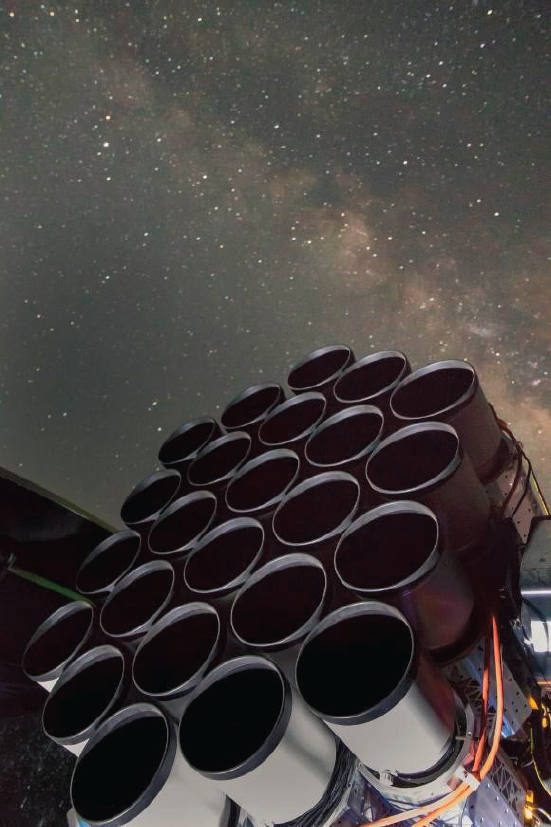
see a more gradual transition from air to glass as it enters the lens. This dramatically reduces the amount of scattered light, making the telescope ideal for imaging extended objects with very low surface brightness in the presence of bright foreground stars. This capability has led to a plethora of unexpected discoveries, including new companion galaxies surrounding the Milky Way, extremely dim galaxies that consist almost entirely of DM, and other apparently very sparse galaxies that have unexpectedly little DM (see, e.g., Figure 7.9).
Another example is the recent demonstration that it is possible to build planar ion traps in commercial complementary metal oxide semiconductor (CMOS) manufacturing facilities, which can offer improved design reproducibility, lower fabrication costs, and scalability. Standard CMOS processes, including doped active regions and metal interconnect layers, allow co-integration of CMOS digital and analog electronic circuits, as well as devices for all-optical control and detection. This approach to ion traps replaces the surface electrodes with a metal layer acting as the ground plane between a trapping layer and the underlying p-type doped silicon substrate. Incorporating the integrated photonics techniques described above, commercial CMOS technologies enable co-design and fabrication of robust and stable platforms for large-scale quantum processing in trapped ion arrays.
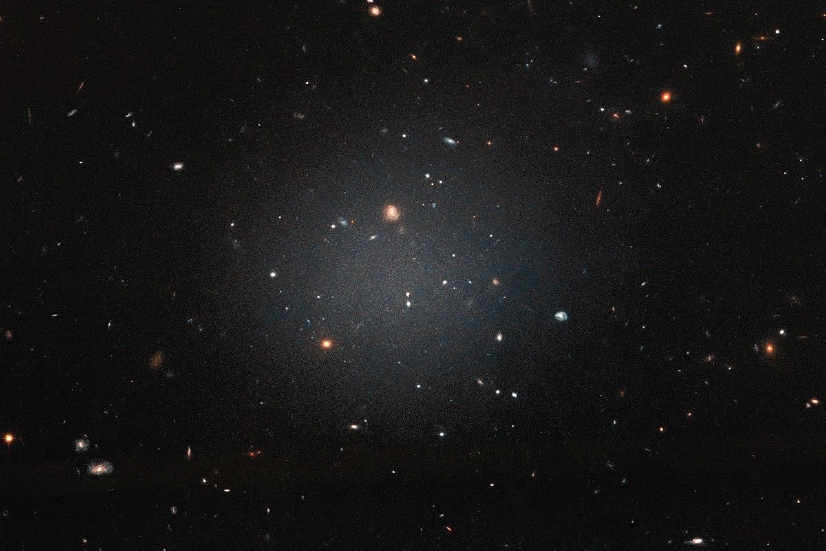
AMO Creates New Technologies for Business
Over the past five decades, AMO fundamental science has led to hundreds of inventions and new technologies that touch our daily lives. Some of the areas impacted include the following:
- New imaging and analysis techniques for biomedicine;
- Flat-panel TVs, computer and mobile-phone displays (now 3D);
- Cheaper, more efficient light sources;
- Solar cells;
- Enhanced navigation and communications;
- Improved national security and defense;
- Chemical, biological, and environmental sensors; and
- Power transmission.
In addition, many innovations—such as high-resolution microscopes and telescopes, and frequency combs for metrology and communication—substantially enhance our ability to do experimental science and build new commercially available disruptive technologies. Without a specific application in mind, 50 years ago, Charles Kao asked a simple question: is there a limit to how clear glass can be made? After more than a decade of work, his discoveries, based on answering that question, led to practical optical fiber telecommunications and the Internet. Similarly, in the 1980s and 1990s, researchers began exploring the use of submicron silicon-on-insulator optical structures to create a wide variety of devices and functionalities, launching the field of “silicon photonics.” Many of these ideas have been adopted by industry to create high-performance alternatives to copper wiring for data communications in high-performance computers and large-scale data centers. Data centers and high-performance computers are likely to be the main consumers of optical chips, which consist of massively integrated lasers, modulators, and detectors acting as transmitters and receivers of ultrahigh bandwidth data. As shown in Figure 7.10, photonic devices and circuits can now be fabricated in standard CMOS foundries with densities and performance that exceed those of a decade ago by factors of 10 to 1,000.
The interactions between researchers and industry in large-scale integrated nanophotonics has led to a fruitful circle of research and advanced development, where improved scalable fabrication of silicon photonic components can be adopted by AMO scientists, and the discoveries provided by those scientists can in turn drive new commercial offerings. At this time, silicon photonics has not become as ubiquitous as silicon electronics, primarily because integrated optics continues to follow a “vertical” business model, where design and manufacturing are performed by each company separately. By contrast, the CMOS industry has

adopted a “horizontal” approach that encourages design, fabrication, and packaging distributed across multiple vendors, across a broad industrial ecosystem. Democratizing integrated nanophotonics—and extending the reach and duration of the virtuous circle—by opening photonic process design kits (PDKs) to all customers at each CMOS foundry could provide a platform for the same sort of multi-project wafer runs that are the staple of electrical engineering education, research, and advanced development. These tools will represent the know-how for high-yield silicon photonic device and circuit fabrication in much the same way that current electronic PDKs provide this service for the entire electronics industry. There is a rich opportunity here to continue the creation of AMO-inspired science and engineering user facilities at universities with state government and industry-based joint support, as described next.
AMO scientific advances in the past decade have spawned a new cohort of fledgling technology companies aimed at addressing and developing markets that have been opened by those advances. The existence of many of these companies is a direct product of both global government investment in basic science at the university level and global government programs designed to transition academic innovation into commercial markets. While it is too early to assess economic impact, many
of these technologies are potentially disruptive, and could lead to substantial new markets, innovation cycles, and application areas. Examples include recently formed computing companies seeking to develop quantum and photonic computing platforms; secure communication and networking companies seeking to commercialize secure quantum protocols; medical diagnostic companies based on state-of-the-art atomic vapor and solid-state defect magnetometers; precision navigation companies exploiting advances in atom interferometry and time and frequency technologies; environmental monitoring and geophysical exploration companies seeking development of next-generation geophysical and environmental sensors; and other novel sensing companies. Markets include information, communication, medical and aerospace technologies. Other companies address supply chain markets that provide innovative AMO-based building-block technologies such as lasers and photonics components to university, government, and industrial customers. These companies provide a foundation for rapid-cycle innovation by providing off-the-shelf sourcing for otherwise commercially unavailable, leading-edge tools and play a vital and central role in the research and development ecosystem.
JOINTLY SPONSORED INTERDISCIPLINARY RESEARCH LABORATORIES
Interdisciplinary research laboratories and centers in AMO science and engineering-related areas at universities bring researchers and students together from different disciplines. Formation of such successful facilities has gained from models of joint funding including from state governments and industry. This has enhanced economic development through the state governments’ connections with industry and workforce development. In such facilities, students benefit from direct exposure to broader perspectives than just their coursework selection, in line with their career development goals in industry as well as interdisciplinary research in academia. Such centers also enhance opportunities for external fundraising for faculty who want to launch new interdisciplinary research initiatives.
Successful examples of this include the Institute of Optics at the University of Rochester and the Rochester Regional Optics, Photonics, and Imaging Accelerator Program. They benefited from $1.88 million federal funding initially, to help speed the growth of 50 small and medium-size companies, with an additional $200,000 in state support and $700,000 in support from private organizations. Moreover, since 2012, the state of New York has invested $6.1 billion in the economic development of key industries in the Finger Lakes region, including photonics. This “Start-up New York” offers new and expanding photonics companies access to university campuses and to advanced research laboratories, development resources, and experts in key industries. The research environment in these facilities introduces students to interdisciplinary research opportunities as well as to job opportunities in industry.
The Optical Science and Technology Center, the University of Iowa Microfabrication Facility, and the Central Microscopy Facility represent current examples of the original $25 million investment by the state of Iowa in 1987 in interdisciplinary university-based research for laser applications in physics, chemistry, and engineering. This original investment further spurred laser applications in life sciences and the development of companies using optics and photonics tools as well as economic development.
There are other examples that follow this common theme of joint federal, state, and industrial funding. The University of Central Florida (UCF) hosts the Center for Research and Education in Optics and Lasers (CREOL), the largest of four research centers within The College of Optics and Photonics, and the foundational element of the College. In 1986, the Florida legislature acted to provide $1.5 million of annually recurring funds to the UCF budget to support CREOL. In 2007, UCF honored Charles Townes, Nobel Laureate and co-inventor of the laser, by establishing the Townes Laser Institute (TLI) with $4.5 million in funding from the state of Florida. Associated with CREOL, TLI is dedicated to the development of the next generation of laser light engines for applications in medicine, advanced manufacturing, and defense. The University of Arizona’s College of Optical Sciences (OSC), established in 1964, has been an innovation front-runner for 50 years, with award-winning students, researchers, and industry partners. OSC is funded by the state of Arizona as part of the university, and is supported by contracts from industry and government. The state of Montana—particularly in the city of Bozeman—has encouraged graduates of Montana State University to start optics companies with funding and tax incentives. More than 30 companies are thriving in Bozeman today.
FINDINGS AND RECOMMENDATIONS
Finding: Other scientific fields, such as the life sciences, have tremendously benefited from AMO science and its tools, as highlighted by single-molecule fluorescence microscopy and adaptive optics being used for super-resolution cellular imaging in near-native conditions. Subsequent advances in synthetic chemistry and materials science have dramatically improved the reach and impact of AMO science and its tools going beyond traditional AMO sciences. Yet, the cross-fertilization between AMO and other fields is not yet occurring at the highest speed possible because of lack of outreach in terms of awareness and availability of the new tools, techniques, and technologies.
Recommendation: Federal agencies should improve the availability and raise the awareness of the latest AMO technologies for researchers in other fields
of science. Additionally, agencies should create funding opportunities to bridge the latest AMO technologies to other disciplines, specifically targeting early adopters.
Finding: Economic development results from AMO-related science and engineering. As exemplified by the University of Rochester, the University of Iowa, the University of Central Florida, the University of Arizona, and Montana State University, state-sponsored centers of excellence in AMO-inspired fields bring researchers and students together from different disciplines in universities, allowing state governments to make connections with industry and thereby promote workforce development. Students at universities benefit from direct exposure to a broader perspective for their coursework selections by direct exposure to what is needed for a career in research and development in industry. This also promotes interdisciplinary research at universities and enhances opportunities for external fundraising for faculty launching new interdisciplinary initiatives.
Recommendation: State governments should encourage the exploitation of opportunities to compete for economic development in AMO-related science and engineering user facilities at universities using state funding and/or industrial joint support.
Finding: The discussions of engineered quantum matter in Chapters 2 and 4 describe an important emerging field that brings together several disciplines of AMO physics to substantially increase the interaction between material and electromagnetic quantum states. There is great potential for a collaboration between scientists and industry on translational technologies that could miniaturize and scale up a wide range of laboratory-based quantum sensors, including optical clocks and frequency combs. This advance will require a significant increase in the availability of modern advanced photolithography for nanophotonic structures in Si and III-V materials. In addition, students in AMO would benefit greatly from centers dedicated to doctoral training in quantum technologies, modeled on the Centres for Doctoral Training funded by the Engineering and Physical Sciences Research Council in the United Kingdom.
Recommendation: The National Science Foundation and Defense Advanced Research Projects Agency should create funding opportunities that target strong multidisciplinary collaboration between academia and industry to transfer current e-beam lithography methods in engineered quantum matter to advanced photolithography pilot lines.
Recommendation: The National Science Foundation Research Trainee Program should be expanded to ensure that the next generation of post-doctoral fellows are prepared to handle research and innovation challenges across the engineering and physical sciences landscape, particularly in quantum engineering.
Recommendation: The federal government should provide funding opportunities for basic research that enables the development of industrial platforms, such as foundry offerings, to support the integration of photonics and engineered quantum matter.
Finding: Astronomical observations have exposed significant shortcomings in our understanding of AMO science that will require significant scientific advances to address. In order to maximize the benefits of ground-based and satellite-based observations, new contributions from AMO theory and experiment are needed to classify the species observed and to understand in detail the elementary atomic and molecular processes occurring in astrophysical environments.
Recommendation: The National Science Foundation, Department of Energy, and National Aeronautics and Space Administration should support a strengthened community of faculty with the capability to carry out laboratory-based experiments, to develop theory, and to carry out computations in order to maximize the payoff from astrophysical observations and to encourage enhanced support from other funding agencies.






























